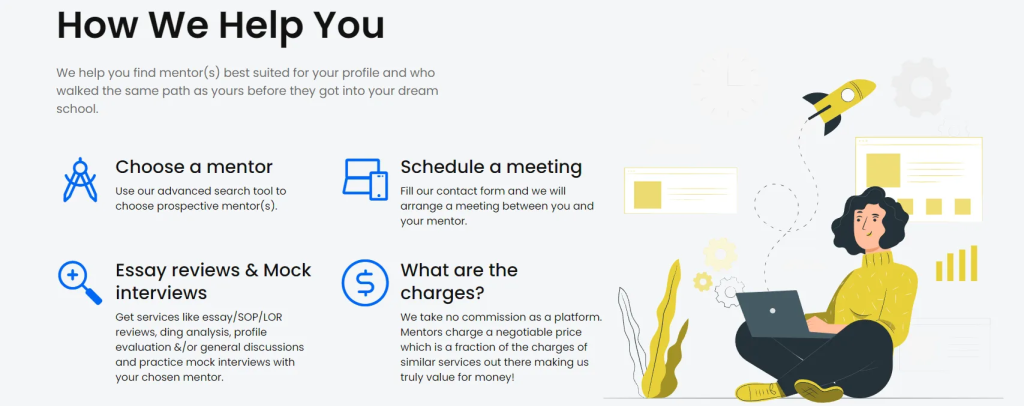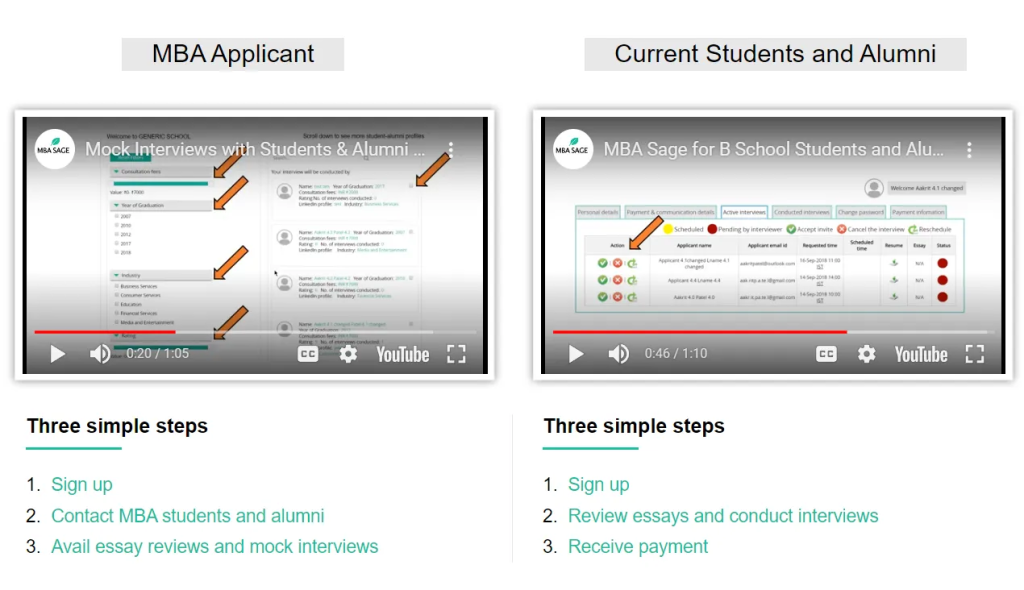Helping 250+ MBA applicants get admissions to colleges like Cornell and ISB
Introduction
In 2018, I partnered with Prashant and Saloni to create a platform that helped MBA applicants secure admissions to top business schools worldwide. In just three months, we facilitated over 250 sales, offering essay reviews and mock interviews. This is the story of that journey.
The concept was straightforward: We connected applicants with mentors who were current students or alumni of their target B-schools. Each mentor had a profile closely matching the applicant’s in terms of education and work experience. These mentors guided applicants in crafting compelling stories for their MBA applications through personalized essay reviews and mock interviews. By charging significantly less than traditional admissions counselors, we made high-quality admissions consulting accessible to a big pool of otherwise unserved applicants.


User Journey
Before we deep dive into this, here’s a summary first:
| Customer Journey | Description | |
|---|---|---|
| 🗣️ | Offering | We focused on essay reviews and mock interviews, helping applicants target the right B-schools with specialized support. |
| 💰 | Pricing | Our USP was affordable, high-relevance support, attracting applicants who typically wouldn’t invest in consulting. |
| 🥅 | Acquiring customers | We took the application submissions and experiences of mentors and compiled them into a single document. Then used this as a lead magnet marketed through ads and forum posting. |
| 🛒 | Placing an order | We created a lead magnet from mentor experiences and marketed it through ads and forums to generate interest. Then we would call the leads to nurture and convert them. |
| 🧑🎨 | Acquiring mentors | Engaging top students as mentors was easy, with many eager to participate, even at lower rates or pro bono. |
| 👓 | Application support | Applicants received personalized coaching through calls and emails, with feedback collected to ensure quality. |
| 🔍 | Adoption, Impact and Scale | In three months, we rapidly scaled, helping clients secure admissions and launch successful careers. |
| 🔮 | Future scope | The potential was vast—more schools, courses like MSBA, and expanded services like job interview prep. |
Complete Deep Dive
Now, let’s dive deeper into each part of the business in detail:
🗣️ Offering:
The admissions consulting market offers standardized services globally. After research, we identified three common offerings:
- End-to-End Support: From selecting schools to mentoring through essays and interviews. Priced per school or session with an upfront booking of a certain number of sessions.
- Application Review: Essay and application review, priced per school.
- Mock Interviews: Conducted before the final interview round.
Given upcoming deadlines for ISB, INSEAD, and Cornell, we launched two targeted offerings most suitable for these colleges’ admissions:
- Essay Review: A one-hour feedback session with a mentor, followed by up to five messages for final adjustments.
- Mock Interview: A 40-minute mock session with a mentor, followed by a 20-minute review of performance and suggestions.
💰 Pricing:
The session price varied based on:
- Mentor Profile: Alumni from higher-ranked schools and professionals with higher hourly rates charged more.
- Relevance to Applicant: High-demand profiles (e.g., consulting, product management) commanded higher fees.
- Service Type: Mock interviews were cheaper than essay reviews, though we opted for a single platform rate for simplicity.
- Mentor’s Country: Currency value differences influenced pricing.
Mentors set their own prices using a slider, reflecting their unique profiles.
- Indian Mentors (e.g., ISB): ~₹5000 per hour.
- International Mentors (e.g., Harvard): ~USD 125 per hour.
We took a 30% commission, with transaction costs added on top, which customers accepted.

Controls section of the website for mentors with an option to set hourly rate
🥅 Acquiring Customer Leads:
Pitch:
Our pitch targeted those who weren’t considering application support. For just ₹5000, they could get a relevant second opinion on their application. Blog posts from top schools and their use of student and alumni panels added credibility to our offering.
We faced challenges with applicants from well-networked institutions. To address this, we pitched the value of practicing with mentors from different backgrounds, emphasizing the benefit of diverse perspectives.
Ultimately, we sold hope at an affordable rate. Despite few inquiries about our success rate, the perceived value of improving their chances drove customers to buy.
Outreach:
We created a lead magnet by compiling essays, applications, and interview experiences from 10 mentors into a single document. This was used to attract potential customers.
A lead magnet prepared for INSEAD interview – It’s a map of what questions to expect in an interview at INSEAD and how to answer them
Lead magnet prepared for ISB Admissions
Lead magnet prepared for ISB Admissions
With the lead magnet ready, we needed to distribute it effectively.
Initially, we considered leveraging our mentors’ networks. However, mentors might prefer converting applicants directly, without involving us as a middleman. In hindsight, a strategy similar to Upraised’s early-stage marketing could have worked, capturing applicants early in their journey. Although conversions would have been challenging, it would have been worth exploring.
The most effective approach, though, was performance marketing. Despite my reservations about it, we ran Google and Quora ads. These ads led to an Instamojo page where applicants could download our content after sharing their details. We then followed up with calls to these leads.
Guerilla Marketing:
We also leveraged promotional posts disguised as user-generated content (UGC) on platforms like Quora, GMAT Club, and Pagalguy. Using proxy accounts, we posted questions about admission support and then responded with subtle plugs for our services. While effective initially, it was risky—we cycled through about 30 accounts before shifting to performance marketing.
One of the posts on GMAT Club we made to get leads.
One of the posts on GMAT Club we made to get leads.
🛒 Placing an Order:
We offered two order placement options:
- Direct Journey: Users could select a mentor, make a payment, schedule, and receive feedback entirely on the platform.
- Manual Journey: We guided users through each step via email and WhatsApp.
Pre-Conversion Journey:
- Identify the right mentor based on:
- Cost
- Education
- Work experience
- Unique attributes
- Availability
- Choose a service
- Check preferred slot availability
- Make the payment
On the platform, here’s how the journey looked like:
Applicant Journey on MBA Sage
When handled manually, I personally guided applicants through the entire process:
- Suggested mentors based on the applicant’s profile using a filtering sheet.
- Coordinated between the mentor and applicant to finalize a suitable time.
- Collected payment once the schedule was confirmed.
- Set up the call on Google Meet, initiated an email thread for prep materials, and facilitated follow-up discussions.
Structure of the sales pitch, the customer segmentations and general sales tenets
Structure of the sales pitch, the customer segmentations and general sales tenets
After selecting a mentor, I would act as a liaison between the mentor and the applicant to finalize a suitable time. Once confirmed, I collected the payment, scheduled the call on Google Meet, set up an email thread for prep materials, and managed follow-up discussions.
🧑🎨 Acquiring mentors
Onboarding mentors was easier than expected, shattering my initial perception of these elite students and alumni.
Drawing from my experience acquiring CHRO leads for an HR-Tech startup, I used a similar approach. I leveraged Linked Helper, a Chrome extension that automates LinkedIn invitations with dynamic messages.
I’d search for keywords like “Indian School of Business,” gather profiles, and send personalized messages via the extension.
Sequence of messages to Students and Alumni of B Schools to onboard them
Sequence of messages to Students and Alumni of B Schools to onboard them
Responses were overwhelmingly positive. Some mentors were willing to help pro bono, while others joined for the extra income, even at lower rates. Many stuck around due to financial pressures, such as loans or less-than-ideal placements.
Once they expressed interest, I’d share more about the company via email and finalize the onboarding.
The onboarding journey was driven through the product. A mentor could sign up on the website using their college’s email id. We’d put filters on the email id structure. For example, a BITS Pilani alumnus needed to have a @alumni.bits-pilani.ac.in email id to be able to sign up as a mentor.
Here are the videos of the mentors’ user journey:
🔍 Post conversion application support:
After conversion, the user journey involved:
- Uploading prep materials.
- Scheduling a review call.
- Attending the review call.
- Engaging in feedback conversations over email.
- Submitting reviews for both the student and mentor.
This process had both a direct online flow and a manual handholding flow. Mentors were assigned during the sales process, and materials could be shared via the platform or email. Scheduling could also be done online or through email communication.
The review call was private, with no recordings provided. Post-call, up to five follow-up emails were allowed to address any remaining doubts.
🔍 Adoption, Impact and Scale:
Targeting ISB, Cornell, and INSEAD, we achieved the following in three months:
- Onboarded 50+ students and alumni from target schools.
- Secured 250+ sales for essay reviews and mock interviews.
It got intense—one mentor even confessed to being on the essay review committee. Interestingly, these committees receive a guidebook from the schools on how to conduct reviews. I never got my hands on one, but maybe someday!
🔮 Future scope:
This idea has immense potential.
Within our product, we could have:
- Scaled to international colleges.
- Solved for CAC.
- Expanded to more courses like MS and MSBA.
Beyond that, similar products could thrive in other verticals:
- Job interview mocks.
- Regular mentorship for skill development.
My belief in this concept is so strong that even after leaving MBA Sage in 2019, I tried relaunching it as Alum Next Door in 2021 with Pratikshya, Harsh, and Dharini. We even caught the attention of Elevation Capital, but balancing this with our full-time jobs proved challenging, and we couldn’t sustain it.
Despite exiting both ventures, I remain bullish on this idea. With AI advancements, I have a fresh approach.
While working on a Chrome Extension for the Verbophobia project at BuildSpace, I discovered Sage—an AI-powered networking chatbot for cohort members.
Sage by Buildspace
I want to build something similar for MBA admissions. By training a model on mentor profiles and application essays, we can create a chatbot that helps applicants brainstorm and guides them through their application process. This bot could also assist in finding the right mentors and scheduling sessions.
Such a platform could be hosted by admissions consulting services or directly by schools to enhance their applicants’ submissions. Though, the unit economics need further exploration.
Currently, I’m working on a contextual chatbot for BrightCHAMPS. If successful, this might be my next venture. Let’s see.